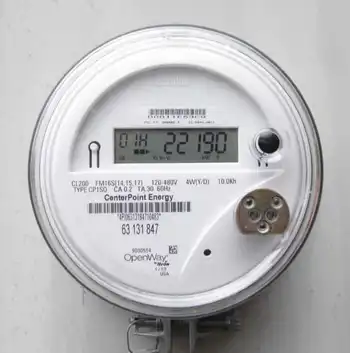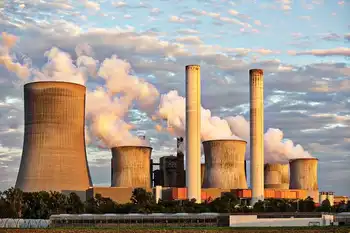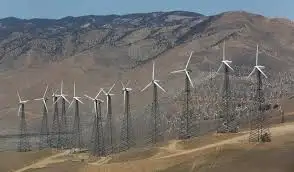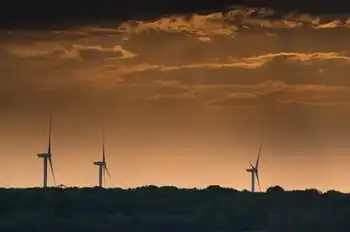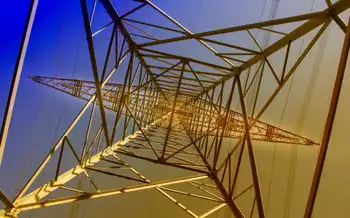Nuclear powerÂ’s core of support gains strength
By Houston Chronicle
CSA Z462 Arc Flash Training - Electrical Safety Essentials
Our customized live online or in‑person group training can be delivered to your staff at your location.

- Live Online
- 6 hours Instructor-led
- Group Training Available
With no major U.S. accidents during that period, public opinion has slowly swung in favor of splitting atoms to meet the country’s voracious power demands. The cost of natural gas — a competitor to nuclear — spiked to $13 per thousand cubic feet last year, although it has since fallen. And in a world worried about carbon dioxide, nuclear energy stands out, because it produces virtually no greenhouse gases.
Finally, during a Bush administration friendly to nuclear power, the federal government has begun providing generous loan guarantees for new reactor construction.
Because of these trends, the Nuclear Regulatory Commission during the last two years has received 17 applications for 26 new nuclear reactors, most of them at existing facilities. And during this year something will likely happen that hasnÂ’t in three decades: a U.S. power provider is expected to receive a license to begin clearing land for a new reactor.
“There’s clearly momentum building in favor of nuclear energy,” said Sean McDeavitt, a Texas A&M University assistant professor of nuclear engineering.
Among the first to apply for a license was NRG Texas, which seeks to expand its existing South Texas Project near Bay City. The two proposed units, which the company expects would begin operations by 2016, would produce an additional 2,660 megawatts, enough electricity to supply 2.1 million homes.
“We think nuclear energy plays an important role in the near future,” said Kevin Howell, president of NRG Texas.
Two other power providers also submitted license applications last year. Exelon wants to build two reactors in Victoria County, and Luminant wants to add two reactors to its Comanche Peak facility near Glen Rose in North Texas. Amarillo Power is expected to apply this year to license a two-reactor plant in the Panhandle, according to the Nuclear Regulatory Commission.
Even most advocates of nuclear energy worry, however, that the present nuclear resurgence is transitory.
As part of a 2005 energy law, billions of dollars in subsidies were offered to the first few energy companies that built plants. ItÂ’s possible that after a few reactors are constructed and exhaust these benefits, new construction will cease.
President-elect Barack Obama, too, has signaled a more cautious approach than President George W. Bush, saying the technology should proceed only if proved “safe and clean.” And the issue of nuclear waste disposal remains a quagmire, with no imminent agreement to move forward on building a waste repository at Yucca Mountain in Nevada, where the project is widely opposed. Obama’s choice for energy secretary, Steven Chu, has previously expressed doubts about Yucca Mountain.
“I just don’t think there will be a big renaissance,” said Peter Hartley, an energy expert at Rice University. “I believe the new administration will be much tougher on nuclear energy. Even if they implement carbon dioxide controls, I think the result will be primarily more natural gas plants, rather than wind.”
Nuclear energy and natural gas now provide about 20 percent each of the countryÂ’s electricity needs. Coal, by far the dirtiest energy source in terms of carbon dioxide, generates almost half the nationÂ’s electricity. In Texas, natural gas is the leading generation fuel at about 45 percent.
Carbon dioxide emission from natural gas is about half that of coal.
But as consumers discovered last summer, the price of natural gas generally is tied to the price of oil and can rise quickly. Also, there remains a wide range of uncertainty about the total amount of recoverable natural gas in the world, and whether these reserves could sustain a natural gas economy for more than a few decades.
So hereÂ’s where nuclear energy has key advantages: ThereÂ’s enough uranium to power much of the world for decades, and the price is more stable than for fossil fuels. Once nuclear plants are built, operating costs are considerably cheaper than for any fossil fuel, including coal.
But nuclear plants are expensive to build, costing billions, and prone to overruns, delays and environmental lawsuits.
Add in capital costs, RiceÂ’s Hartley said, and nuclear energy becomes more expensive than coal or natural gas.
This is a point seized upon by environmental groups — many of which haven’t rallied behind nuclear energy despite its near-zero greenhouse gas emissions.
“Nuclear power is the most expensive way anybody has ever figured out how to boil water,” Josh Dorner of the Sierra Club said. “Ignoring the waste problem, you just can’t justify the costs.”
All this leads to a question: At this moment of opportunity for nuclear energy, when the outlook is more favorable than at any time since the 1960s, is there a path by which the United States might significantly increase its reliance on nuclear energy, address its waste issues and increase energy security?
Experts see two paths: One comes through policy, the other new technologies.
The policy path is straightforward, though not easy, energy experts say: Further simplify regulatory approval for plants; pick a design like Japan and France have done to standardize the construction of plants; develop legislation to dissuade environmental lawsuits; and, finally, solve the nuclear waste issue.
“It would certainly take a Manhattan Project-type commitment to get that done,” said McDeavitt, the A&M nuclear engineer, referring to the effort during World War II to develop the atomic bomb.
A recognition of these policy hurdles has led to numerous technological approaches that circumvent some of the existing problems with nuclear energy and that one day may lead to a wider adoption of fission power.
The broadest is an international effort by more than a dozen nations, including the U.S., to develop a new generation of reactors, called the Generation IV International Forum.
One goal of this new reactor design is to use nearly all of the available natural uranium in a reaction. Most of todayÂ’s reactors can use only a small fraction of the uranium fuel in nuclear reactions, typically less than 1 percent. Using a larger fraction and developing reprocessing techniques would greatly extend the lifetime of the worldÂ’s supply of uranium and significantly cut waste.
Those involved in the initiative hope to deliver a design for commercial construction by 2030.
A second technological approach is to develop reactors that use thorium, a radioactive element that can be transformed into a uranium-based fuel. The reason for the interest in thorium is simple: There are enough thorium reserves to power the world for centuries.
The United States has generally not supported research of thorium, because it transforms into uranium-233, which has the potential to be used for weapons. However, some countries with abundant thorium reserves but low amounts of uranium, such as India, have pushed the technology forward.
Now, the United StatesÂ’ position on thorium may be softening. In October, Sens. Orrin Hatch, R-Utah, and Harry Reid, D-Nev., sponsored legislation that would provide $250 million over five years to spur the development of thorium reactors.
“All I can do is put forward a technically feasible way to create all of the energy this planet needs for the next thousand years,” said Peter McIntyre, a Texas A&M physicist who has worked on thorium reactors. “To move forward, it’s up to the government to change its policy toward thorium power.”
Another new approach involves making small “backyard” reactors. The most aggressive proponent is Santa Fe, N.M.-based Hyperion Power, which seeks to build hot-tub-size reactors that can generate 25 megawatts of electricity, or enough juice to power 20,000 homes.
The company is already negotiating with several entities for the sale of 200 reactors, each at a cost of about $30 million. The idea is to deliver power at a cost of less than 10 cents a kilowatt-hour to locations — say remote areas of Alaska, military installations or industrial locations in Canada’s tar sands — where it’s difficult to obtain conventional power, said John Deal, Hyperion’s chief executive officer.
Hyperion is still finishing its manufacturing design and hopes to obtain federal licensing from the Nuclear Regulatory Commission and other bodies within a few years. Deal expects to deliver the first units to customers in less than five years.
Much of the demand has come from overseas. The United States, where much antipathy remains toward nuclear energy despite public surveys showing falling opposition, will have to wait.
“Honestly,” Deal said, “right now, I’m not really interested in fighting American ignorance about nuclear power.”






